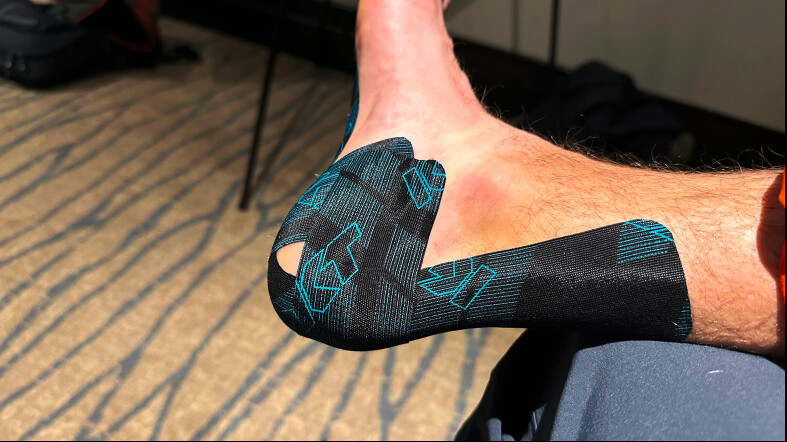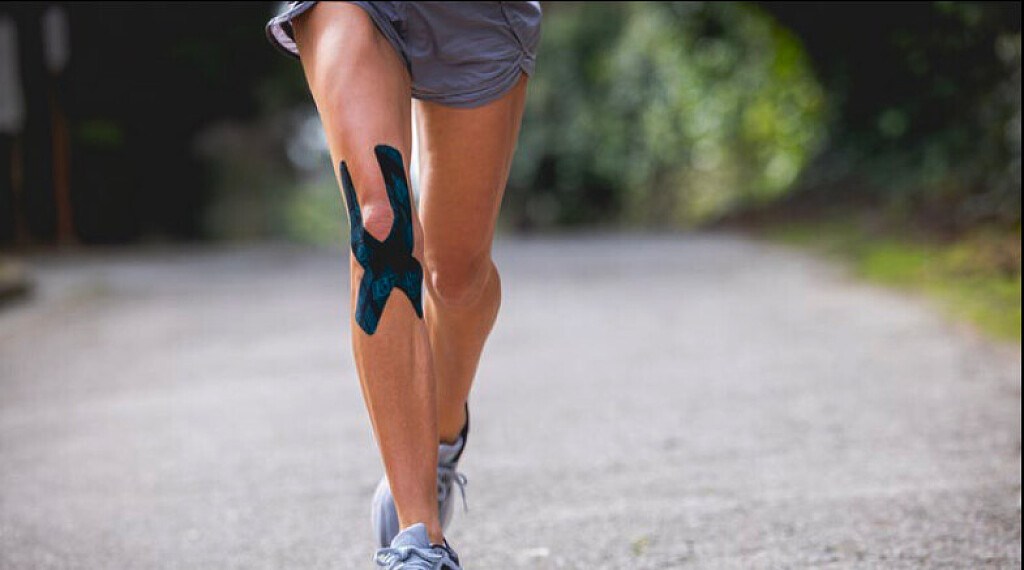Running News Daily
Running News Daily is edited by Bob Anderson. Send your news items to bob@mybestruns.com Advertising opportunities available. Train the Kenyan Way at KATA Kenya and Portugal owned and operated by Bob Anderson. Be sure to catch our movie A Long Run the movie KATA Running Camps and KATA Potato Farms - 31 now open in Kenya! https://kata.ke/
Index to Daily Posts · Sign Up For Updates · Run The World Feed
The cooling power of KT Tape Pro Ice provided unexpected pain relief
For years, I’ve viewed kinesiology tape—those brightly colored stripes you see on the legs and shoulders of athletes—as nothing more than snake oil, something people used for show without any real benefits. All my experiences with athletic tape involved protecting an injured joint by tightly wrapping and immobilizing it. I was skeptical that a few strips of tape on the skin could do much.
I hadn’t, however, actually used the product. So when I was invited to attend a summit to learn the science behind a new kinesiology tape product and try it out, I eagerly accepted the invite. As someone deeply passionate about running, climbing, and skiing, and having seen many pro-level athletes embrace the tape, I was intrigued to personally discover if there was substance behind the hype or if it was merely smoke and mirrors, as I had previously believed.

KT Tape funded the travel for this review, but our opinions are our own. If you click or buy through our links, we may earn an affiliate commission. This supports our mission to get more people active and outside. Learn more.
Kinesiology tape is a stretchy, elastic cotton strip with an adhesive backing. I learned it is designed to replicate the elasticity and thickness of human skin, offering support, stability, and pain relief while allowing free movement. It is most commonly used by athletes and physical therapists to aid in the treatment of muscle and joint injuries and enhance performance by reducing inflammation and improving circulation.
When applied correctly, kinesiology tape lifts the skin, decompressing the fascia and allowing lymphatic fluid to drain rather than build up. Blockage of lymphatic fluid can cause swelling and pain. Lifting the skin and opening up blood flow also facilitates the transport of white blood cells to the area, thus reducing harmful bacteria and waste products from cells and tissues.
When I looked at the scientific literature on kinesiology tape, I found the evidence mixed. While some studies suggest that it may provide benefits such as pain relief, improved muscle function, and reduced swelling, other research indicates that its effects may be no different from a placebo.
One 2012 meta-analysis found its benefits trivial, citing it “may have a small beneficial role in improving strength and range of motion in certain injured cohorts,” but went on to say that further studies are needed to confirm these findings. Another meta-analysis, this one in 2015, found applying kinesiology tape was “superior to minimal intervention for pain relief,” (or, put another way, better than doing nothing) but concluded it was not better than other treatments to reduce pain. This ambiguity only reinforced my skepticism, but also increased my interest in why the tape has become so popular.
The summit, held in Park City, Utah, centered around the launch of KT Tape Pro Ice, a new kinesiology tape infused with cooling menthol. Menthol, a compound available in both natural and synthetic forms, reduces pain sensation when applied to the skin by creating a cooling effect. KT Tape Pro Ice incorporates menthol into its adhesive, providing the dual benefits of kinesiology tape and pain-numbing menthol.
The event planners’ strategy was to spend time working out—skiing and snowshoeing—to induce muscle soreness and fatigue, then use KT Tape Pro Ice to alleviate that soreness and any accompanying pains. Doubtful that the menthol-infused version would make any difference, I was in for a surprise.
As an avid runner, I frequently deal with nagging aches and injuries. Currently, I’ve been grappling with a persistent Achilles injury, which—despite using topical pain relievers, seeing physical therapists, and even considering surgery—has been an issue for several years. I was hopeful that Pro Ice might help. I have Haglund’s deformity, a large bump on the back of my heel that, when pressure is applied, swells and causes pain. Since ski boots fit tightly, I’m usually in pain immediately following a day of skiing. This time was no exception. We were slated to go snowshoeing the night after skiing, creating a perfect test of KT Tape Pro Ice’s pain-relieving qualities.
After skiing, we were handed samples of KT Tape Pro Ice and instructed to apply it to any painful areas. Experts were available to assist with the application. The proper application method, they explained, is called anchor, stretch, anchor. You stretch the center of the tape, apply it to the skin, and leave about two inches unstretched at each end to secure it to your limb. Given I was completely new to this, I opted to have an expert apply it to ensure it was done correctly.
Within a few minutes, I could feel the menthol working. There was a strong cooling sensation that did indeed seem to override my pain. Usually, my Achilles stiffens when I rest after activity, but the tape also helped alleviate that. It felt like it prevented my Achilles from cooling down and tightening up during periods of inactivity. I could feel the menthol working for around four hours, and it reactivated when I started sweating during snowshoeing.
Once I got home, I continued testing KT Tape Pro Ice on my Achilles when it was sore and also on my lower back for pain caused by moving large heavy objects. When applying the tape at home, the cooling effect was nowhere near as strong on my Achilles as it was initially at the event, but it felt stronger on my lower back pain.
We were told that each person would experience the menthol differently. Some may have a strong reaction to the cooling, with it lasting four to eight hours, while others may not feel anything at all, adding the cooling effect may even vary between applications on the same person. Apart from this warning that the cooling effect may vary between applications and body parts, and the fact that I was applying it myself, I’m unsure why it wasn’t as effective on my Achilles on subsequent applications. Luckily, my Achilles has not been painful enough that I felt I needed serious relief—which may be another explanation for the reduced sensation.
I’ve continued to test it on various body parts such as sore forearms from rock climbing and sore thighs from running—and each time it provided pain relief and improved post-soreness mobility.
I still haven’t tried kinesiology tape without menthol, and I’m not sure I’ll need to as long as I have the Pro Ice version. The addition of menthol really brings the tape to life. Every time I’ve used it, I immediately feel the tape working, significantly reducing my perception of soreness, and allowing me to work out again sooner. After testing KT Tape Pro Ice, I’m completely convinced of its benefits and have even become somewhat addicted to it.
Here’s the thing: KT Tape is safe—no scientific studies I’m aware of have reported adverse effects from using it. Furthermore, while the studies are ambiguous about its benefits, there are countless anecdotal stories of KT Tape helping individuals manage injuries during both exercise and daily activities for many years. If the worst outcome of it not working is losing a few bucks, there’s little reason not to try it.
by Outside Online
Login to leave a comment




